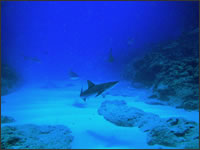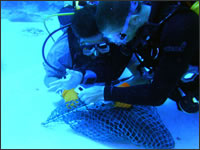Error processing SSI file
|
Mission Blog: August 26, 2009
Grouper Tagging at Kure Atoll
By Yannis Pastamatiou, PhD, Scientist, Diver

|
|
Galapagos sharks descend into the canyon at Kure atoll.
(Photo:Yannis Papastamatiou/NOAA)
|
One of the things that make the northern most atolls unique is the presence of the Hawaiian grouper (Epinephelus quernus) in shallow water. This becomes particularly apparent at Kure atoll where the curious fish come cruising up to check out any visiting researchers, often as soon as they roll into the water. For the past 4 years I have been assisting my colleague Carl Meyer, in a project looking at the movements of top level predators (sharks, jacks, snappers and grouper) within and between the atolls of the north western Hawaiians islands. The aim of the project is to answer basic questions such as: Do predators move between atolls, or stay at one location? Do they show predictable patterns of movement? How large an area would you need to protect these fish? We try to answer these questions by surgically implanting small transmitters in the fish, which emit a high frequency acoustic signal. These transmitters can be detected by a network of underwater receivers which we have placed on every atoll and island of the North Western Hawaiian Island chain. By annually downloading these receivers we start to get an idea of who goes where and when. Normally we catch our target animals from a boat, but the grouper require a special technique: tagging underwater.

|
|
Brian Bowen (left) restrains a grouper while Yannis Papastamatiou (right) surgically implants an acoustic transmitter.
(Photo:Kim Tenggardjaja/NOAA)
|
We roll over the side of the boat off the west side of Kure into water about 60ft deep. A fairly spectacular series of spur and grooves habitat is below and we descend looking for grouper. There is a descent current and several Galapagos sharks swimming around. I see a grouper and swim over to him, putting a piece of bait on a hand line I carry. The inquisitive grouper quickly takes the bait and is hooked, after which we secure him in a hand held dip net. Brian Bowen restrains the fish on the bottom, while I surgically implant a transmitter, apply an external dart tag and get ready to release it. Looking up I see that the canyon is absolutely full of Galapagos sharks. We have found that nothing gets the sharks more riled up than the low frequency sounds produced by a struggling grouper. We release the grouper and make sure that it has safely gotten into a hole in the reef where it will be safe from sharks while it recovers.
We leave the bottom and decide to drift with the current looking for some more groupers. We are followed by our constant group of shark companions, and we even have a manta ray swim over us. Unfortunately we see no more grouper on that dive or any other dive at Kure. It's strange; some years there are grouper all over the island, some years just a few. Hopefully, over time we will be able to figure out why.
|



